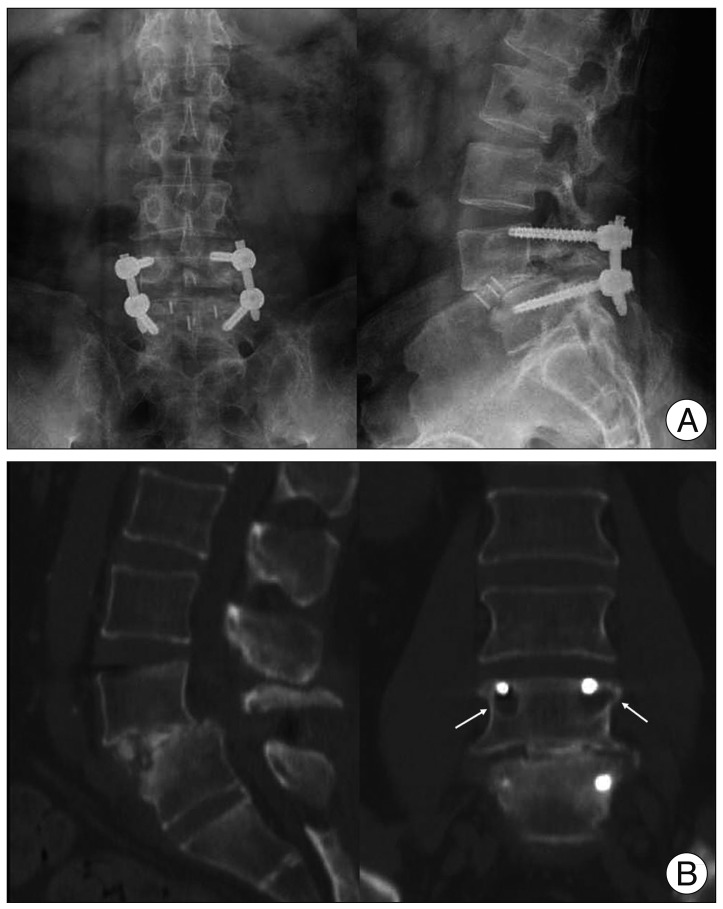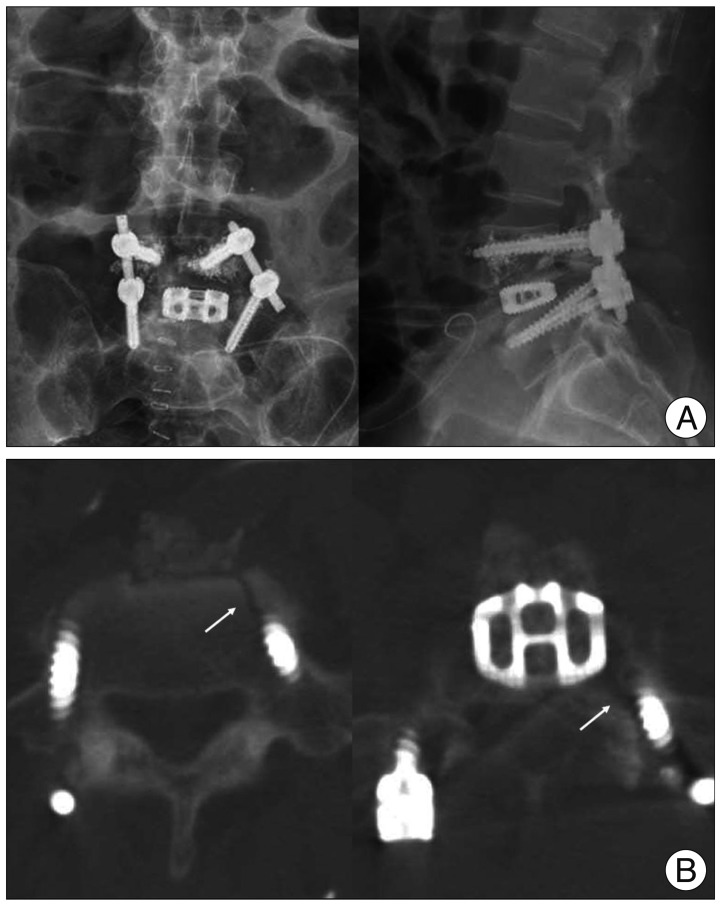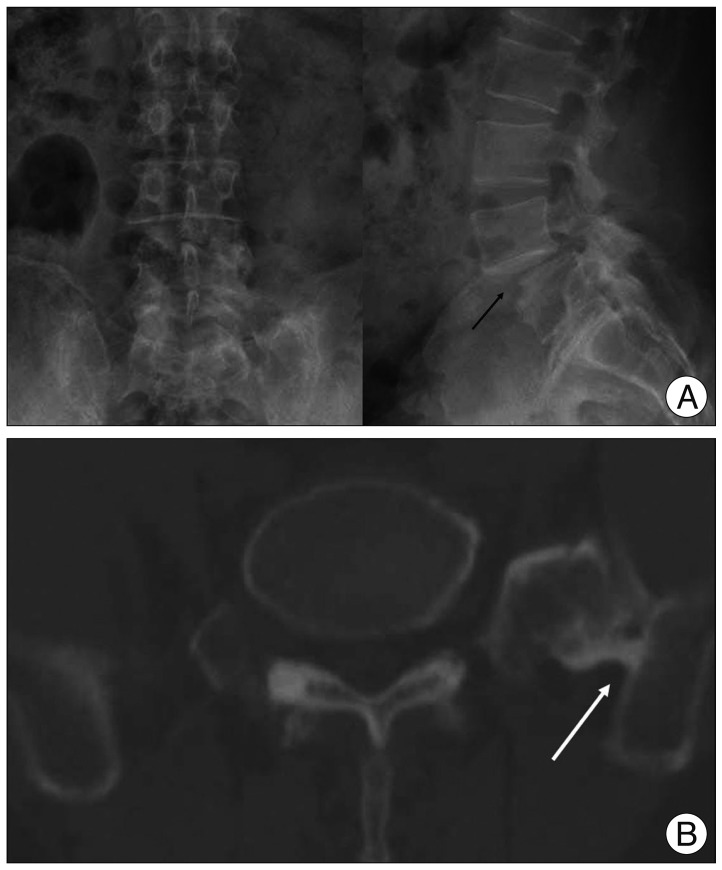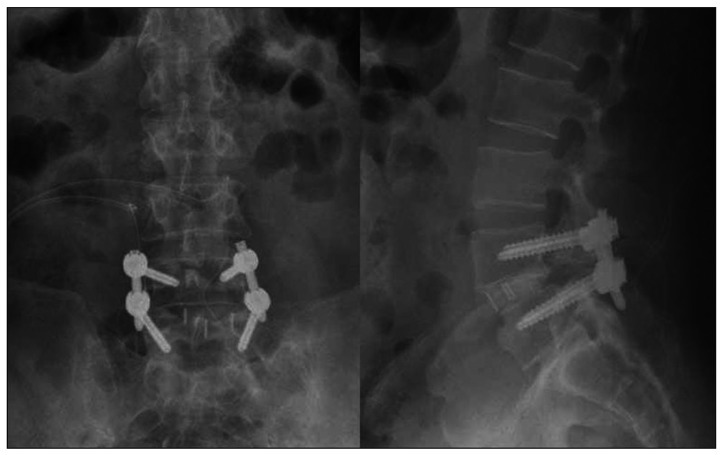1. Abbushi A, Cabraja M, Thomale UW, Woiciechowsky C, Kroppenstedt SN. The influence of cage positioning and cage type on cage migration and fusion rates in patients with monosegmental posterior lumbar interbody fusion and posterior fixation. Eur Spine J. 2009; 18:1621–1628. PMID:
19475436.

2. Aihara T, Takahashi K, Ogasawara A, Itadera E, Ono Y, Moriya H. Intervertebral disc degeneration associated with lumbosacral transitional vertebrae : a clinical and anatomical study. J Bone Joint Surg Br. 2005; 87:687–691. PMID:
15855373.
3. Castellvi AE, Goldstein LA, Chan DP. Lumbosacral transitional vertebrae and their relationship with lumbar extradural defects. Spine (Phila Pa 1976). 1984; 9:493–495. PMID:
6495013.

4. Cho W, Wu C, Mehbod AA, Transfeldt EE. Comparison of cage designs for transforaminal lumbar interbody fusion : a biomechanical study. Clin Biomech (Bristol, Avon). 2008; 23:979–985.

5. Elster AD. Bertolotti's syndrome revisited. Transitional vertebrae of the lumbar spine. Spine (Phila Pa 1976). 1989; 14:1373–1377. PMID:
2533403.
6. Foley KT, Holly LT, Schwender JD. Minimally invasive lumbar fusion. Spine (Phila Pa 1976). 2003; 28(15 Suppl):S26–S35. PMID:
12897471.

7. Fukuta S, Miyamoto K, Hosoe H, Shimizu K. Kidney-type intervertebral spacers should be located anteriorly in cantilever transforaminal lumbar interbody fusion : analyses of risk factors for spacer subsidence for a minimum of 2 years. J Spinal Disord Tech. 2011; 24:189–195. PMID:
20634726.

8. Grant JP, Oxland TR, Dvorak MF. Mapping the structural properties of the lumbosacral vertebral endplates. Spine (Phila Pa 1976). 2001; 26:889–896. PMID:
11317111.

9. Humphreys SC, Hodges SD, Patwardhan AG, Eck JC, Murphy RB, Covington LA. Comparison of posterior and transforaminal approaches to lumbar interbody fusion. Spine (Phila Pa 1976). 2001; 26:567–571. PMID:
11242386.

10. Kettler A, Schmoelz W, Kast E, Gottwald M, Claes L, Wilke HJ. In vitro stabilizing effect of a transforaminal compared with two posterior lumbar interbody fusion cages. Spine (Phila Pa 1976). 2005; 30:E665–E670. PMID:
16284577.

11. Kim NH, Suk KS. The role of transitional vertebrae in spondylolysis and spondylolytic spondylolisthesis. Bull Hosp Jt Dis. 1997; 56:161–166. PMID:
9361917.
12. Kiner DW, Wybo CD, Sterba W, Yeni YN, Bartol SW, Vaidya R. Biomechanical analysis of different techniques in revision spinal instrumentation : larger diameter screws versus cement augmentation. Spine (Phila Pa 1976). 2008; 33:2618–2622. PMID:
19011543.

13. Konin GP, Walz DM. Lumbosacral transitional vertebrae : classification, imaging findings, and clinical relevance. AJNR Am J Neuroradiol. 2010; 31:1778–1786. PMID:
20203111.

14. Lauber S, Schulte TL, Liljenqvist U, Halm H, Hackenberg L. Clinical and radiologic 2-4-year results of transforaminal lumbar interbody fusion in degenerative and isthmic spondylolisthesis grades 1 and 2. Spine (Phila Pa 1976). 2006; 31:1693–1698. PMID:
16816765.

15. Lowe TG, Tahernia AD, O'Brien MF, Smith DA. Unilateral transforaminal posterior lumbar interbody fusion (TLIF) : indications, technique, and 2-year results. J Spinal Disord Tech. 2002; 15:31–38. PMID:
11891448.

16. Lund T, Oxland TR, Jost B, Cripton P, Grassmann S, Etter C, et al. Interbody cage stabilisation in the lumbar spine : biomechanical evaluation of cage design, posterior instrumentation and bone density. J Bone Joint Surg Br. 1998; 80:351–359. PMID:
9546475.
17. McCord DH, Cunningham BW, Shono Y, Myers JJ, McAfee PC. Biomechanical analysis of lumbosacral fixation. Spine (Phila Pa 1976). 1992; 17(8 Suppl):S235–S243. PMID:
1523506.

18. Ngu BB, Belkoff SM, Gelb DE, Ludwig SC. A biomechanical comparison of sacral pedicle screw salvage techniques. Spine (Phila Pa 1976). 2006; 31:E166–E168. PMID:
16540856.

19. Nguyen HV, Akbarnia BA, van Dam BE, Raiszadeh K, Bagheri R, Canale S, et al. Anterior exposure of the spine for removal of lumbar interbody devices and implants. Spine (Phila Pa 1976). 2006; 31:2449–2453. PMID:
17023854.

20. Pawar UM, Kundnani V, Nene A. Major vessel injury with cage migration : surgical complication in a case of spondylodiscitis. Spine (Phila Pa 1976). 2010; 35:E663–E666. PMID:
20505562.
21. Proubasta IR, Vallvé EQ, Aguilar LF, Villanueva CL, Iglesias JJ. Intraoperative antepulsion of a fusion cage in posterior lumbar interbody fusion : a case report and review of the literature. Spine (Phila Pa 1976). 2002; 27:E399–E402. PMID:
12221375.
22. Taneichi H, Suda K, Kajino T, Matsumura A, Moridaira H, Kaneda K. Unilateral transforaminal lumbar interbody fusion and bilateral anterior-column fixation with two Brantigan I/F cages per level : clinical outcomes during a minimum 2-year follow-up period. J Neurosurg Spine. 2006; 4:198–205. PMID:
16572618.







 PDF
PDF ePub
ePub Citation
Citation Print
Print





 XML Download
XML Download